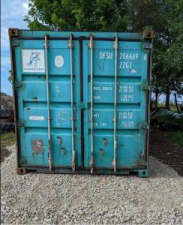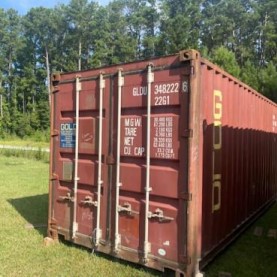Overview of the different container types
Containers vary in dimension, weight and design features. Here you will find an overview of the different types of containers to help you identify the right container for your goods.
What Are Shipping Containers?
Shipping containers are large, strong, rectangular boxes that are used to transport goods by ocean, land, and air. They are typically made of steel but can also be made of aluminum and are designed to be stackable and weatherproof. Shipping containers come in a variety of sizes, but the most common are 20 feet (6.1 meters) and 40 feet (12.2 meters) long.
Where Did Shipping Containers Come From?
In 1852, Malcom McLean was born in North Carolina. McLean was a truck driver who became interested in the efficiency of shipping cargo after he saw how much time was wasted loading and unloading cargo onto ships. In 1956, McLean bought a shipping company and began using containers to transport cargo. This method was much faster and more efficient than the traditional method of using cranes to load and unload cargo onto ships.
Since the introduction of shipping containers, the efficiency of transporting cargo has increased dramatically. Containers can be loaded and unloaded quickly and easily, and they can be stacked on top of each other, which saves a lot of space. Shipping containers have also made it possible to transport cargo by rail and road, which has further increased the efficiency of the shipping industry.

These containers play an imperative position in global trade and make certain that cargo makes it to its vacation spot in one piece. Let’s take a seem at some of the most typically used sorts of delivery containers:
Dry storage containers are additionally recognised as general-purpose containers and are the most broadly used transport containers. They are utterly enclosed and have sturdy roofs, floors, and sidewalls.
These containers come in more than a few sizes standardized by way of the ISO. Typically, their sizes are 20 ft, 40ft, and 10ft. Dry containers additionally come with unique adaptations, such as liner luggage for transport liquid bulk cargo.
- Flat rack container
Flat rack containers have collapsible slides, which makes it viable to keep a large vary of cargo. The aspects of the container can be folded to make a flat rack. In these containers, the give up partitions are sturdy and steady ample to impenetrable the cargo in place.
These delivery containers are perfect for outsized cargo such as development materials, heavy machinery, vehicles, etc.
- Open pinnacle container
Open-top delivery containers are constructed so that their pinnacle can be eliminated absolutely to accommodate cargo of any peak easily.
They are appropriate for tall equipment or different cumbersome items that can’t be loaded via the container’s door. In the case of such cargo, with the assist of a crane or rolling bridge, items can be immediately loaded into the container from the top. These containers are handy in 40′ and 20′ and have lashing rings installed. These rings are connected to the top and decrease facet rails and nook posts to impenetrable the cargo.
- Tunnel container
As the title suggests, tunnel containers have doorways on each ends. It enables handy and rapid loading and unloading of cargo. They are instrumental in delivery metal or different heavy metals as the open doorways permit extra space.
Both ends of the delivery container have a strong locking mechanism and weather-tight seals to preserve cargo blanketed at some stage in transit.
- Open aspect storage container
Open-side storage containers are supplied with doorways that can trade into completely open sides. They hence provide a a whole lot wider room for the loading of materials. The gadgets are pretty similar to the ordinary dry containers however what units them aside is that their doorways can open totally on the aspect too.
These containers usually are on hand in 20′ and 40′ and are used for items that can’t without difficulty pass by thru ordinary doors.
- Refrigerated ISO containers
Refrigerated ISO containers are temperature-regulated transport containers. A low managed temperature is maintained in these containers. They are in the main used to transport perishables such as fruits, meat and vegetables, and pharmaceutical items that require a temperature controlled environment.
Also recognized as reefers, they normally come in 20’ and forty They are many times made from weathering metal recognized as ‘Cor-ten’ steel.
- Insulated or thermal containers
Thermal containers are storage gadgets that enable regulated temperature manipulate making it viable to preserve a greater temperature.
The cloth inner the delivery container is such that it can without difficulty maintain excessive temperatures barring getting damaged.
The devices are outfitted with electrical compliance to warmness the air inside the container. They are used for long-distance transportation of merchandise such as foods, organic materials, pharmaceuticals, chemicals, etc.
- Tanks
Tanks are exceptionally used to transport liquid substances in bulk. These containers are made of strong nonetheless or different anti-corrosive substances to make sure sturdiness and safety of the substances being transported.
More: SHIPPING CONTAINERS FOR SALE IN BALTIMORE
- Cargo storage roll container
These containers are foldable and specifically made to transport items in units or stacks. Thick or robust wire mesh and rollers are used to make these units, facilitating effortless motion of goods.
- Half-height containers
As the identify suggests, these containers are more often than not made of metal 1/2 the ordinary full-sized containers’ height. They’re broadly used to transport items in bulk, such as coal, iron ore, stones, etc., which require effortless loading and unloading.
As these containers have a low centre of gravity, they can higher take care of heavier hundreds than taller containers. This makes them appropriate to face up to the harsh industrial environment.
- Car carriers
Car carriers are container storage gadgets mainly constructed for transporting automobiles or cars over lengthy distances. They are furnished with collapsible facets that assist a automobile suit internal the containers barring the threat of harm or shifting from the spot whilst in transit.
- Intermediate bulk shift containers
Intermediate bulk shift containers are storage delivery containers constructed fully for the intermediate delivery of goods.
They are designed to cope with items in bulk and made particularly for delivery substances to a destination.
- Drums
As the identify suggests, drums are round storage gadgets made from steel, fibre, inflexible plastic, light-weight metals, etc.
They are broadly used for the bulk transport of liquid materials. They are smaller in dimension however occupy extra house on a vessel due to their shape.
- Special reason containers
These containers are made to meet precise purposes. These customized made containers are used for excessive profile offerings like the cargo of weapons and arson.
The cloth used in their building relies upon on the motive they want to cater to. 15. Swap bodies
Swap our bodies containers are exchangeable devices used for avenue and rail transport. Commonly used in Europe, they have a convertible top, which makes them appropriate for transport a vast range of goods.
